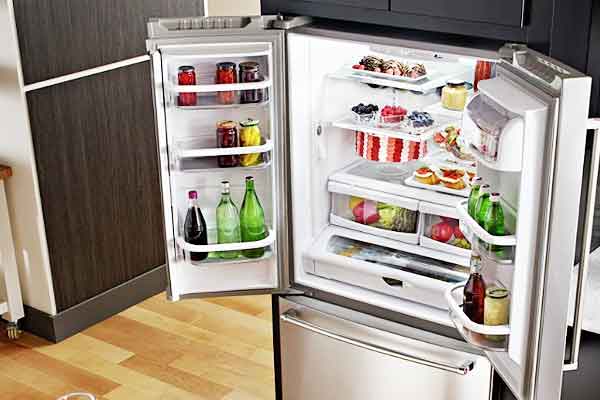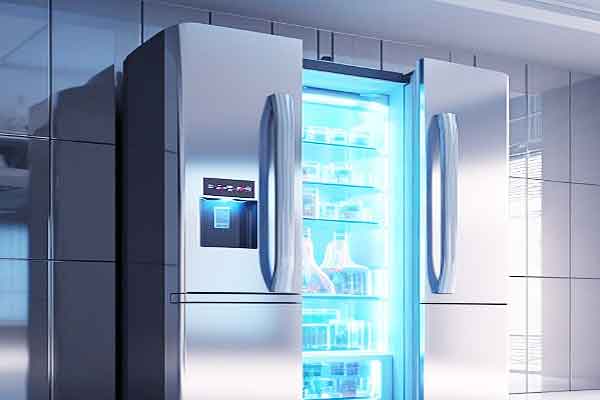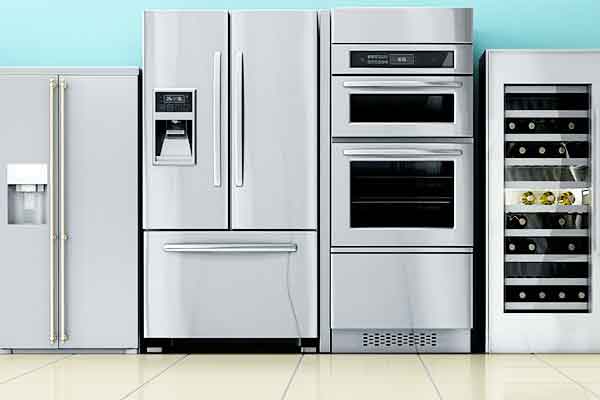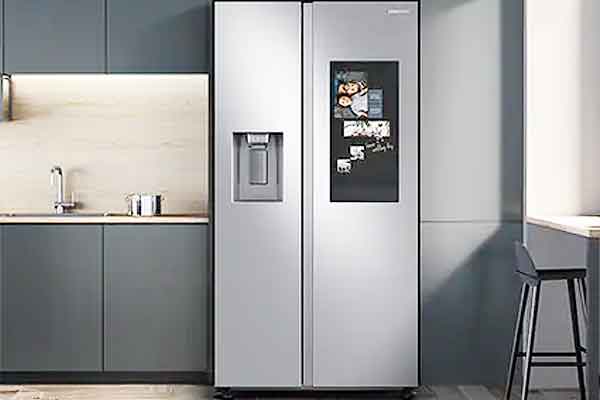Have you ever wondered why are refrigerators so expensive?
Well, the truth is that these products don’t come cheap, and there are several reasons behind their high pricing. Rising production costs and materials play a significant role in driving up the prices of kitchen cabinets. As technology advances, so do the features and capabilities of modern cabinets, which further adds to their expense. Moreover, there is a growing demand for energy-efficient products in the market, pushing kitchen cabinet prices even higher.
Manufacturing a new fridge involves numerous components like ice makers, compressors, and intricate electronic systems. These factors contribute to the overall cost of producing these household appliances, making them costly fridges. Shortages in certain materials can impact supply chains and lead to increased prices for regular fridges. Whether you’re looking for a standard fridge or a smart fridge with all the bells and whistles, be prepared to dig deep into your pockets for both freestanding fridges and inexpensive fridges.
Let’s get started!

The Top Reasons Why Are Refrigerators so Expensive
1. Customization Options
One of the key factors that contribute to the higher cost of built-in refrigerators is the wide range of customization options available. Unlike standard fridges, integrated models offer panel-ready designs that can seamlessly blend with kitchen cabinetry.
This level of customization allows homeowners to achieve a cohesive and aesthetically pleasing look in their kitchen, but it comes at a costly price. The additional materials and manufacturing processes involved in creating these customizable features drive up the overall cost of integrated refrigerators, making them more expensive than inexpensive fridges.
2. Premium Brands and Reputation for Quality
Another reason why built-in refrigerators tend to be more expensive is due to the presence of premium brands in this segment. Manufacturers known for their commitment to quality and innovation often command higher prices for their products, unlike inexpensive fridges.
These brands have established a reputation over time, building trust among consumers who are willing to invest in regular fridges that are reliable, durable, and perform exceptionally well. Therefore, choosing a new fridge from one of these renowned brands may come with a premium price tag.
3. Increased Complexity in Construction
Built-in refrigerators require intricate construction techniques compared to freestanding home appliances. The design must ensure seamless integration into cabinets or surrounding structures while maintaining optimal functionality. This increased complexity adds to the manufacturing costs involved in producing built-in fridges.
Manufacturers need to invest more time and resources into research, development, and engineering processes to meet these specific requirements for household appliances. Consequently, these additional efforts contribute significantly to the overall expense associated with integrated refrigerators and ice makers.
4. Supply and Demand Dynamics
The supply chain dynamics also play a role in driving up the cost of expensive fridges. As demand for these new fridges increases, manufacturers face pressure to meet consumer expectations while maintaining product quality.
Limited production capacities combined with rising demand can lead to scarcity in supply, which further drives up prices due to market forces such as competition among buyers or resellers. The specialized nature of built-in refrigerators may require manufacturers to source unique components or materials, which can also impact the overall cost of regular fridges.
5. Technological Advancements and Features
In recent years, technological advancements in refrigeration have led to enhanced features, such as energy efficiency, smart home integration, and advanced cooling systems.
These advanced features contribute to higher refrigerator prices due to increased production costs and specialized components. Consumers should consider their needs and budget when evaluating the value of these features in relation to the price of the refrigerator.
6. Material and Construction Costs
Using high-quality materials in refrigerator construction ensures durability, reliability, and longevity. Quality materials contribute to a superior product that can withstand daily use and maintain optimal performance over time.
The cost of materials and the complexity of construction directly influence refrigerator pricing. Premium materials and intricate manufacturing processes increase production costs, leading to higher prices for consumers.
7. Brand Reputation and Market Positioning
Brand reputation plays a vital role in refrigerator pricing. Established brands with a history of reliability, innovation, and customer satisfaction often command higher prices due to the perceived value associated with their name.
Market positioning, including factors like brand image, target audience, and competitive landscape, impacts refrigerator prices. Premium brands positioned as offering exclusive features or targeting luxury markets tend to have higher price points compared to budget-friendly options.
8. Research and Development Expenses
Manufacturers invest significant resources in research and development to drive innovation in refrigeration technology. These expenses cover the costs of designing and testing new features and technologies, which are reflected in the pricing of the final products.
Research and development expenses influence refrigerator prices as they contribute to the overall cost of product development. Manufacturers must recover these costs, along with expected profit margins, through pricing strategies.
9. Supply Chain and Manufacturing Costs
The refrigerator supply chain involves various stages, including sourcing raw materials, manufacturing components, assembling the units, and distributing them to retailers. Each step incurs costs that impact the final price of the refrigerator.
Manufacturing costs encompass labor, equipment, facility expenses, and overheads. Efficient manufacturing processes and economies of scale can help manufacturers keep costs low, resulting in competitive pricing for consumers.
10. Regulatory Compliance and Standards
Refrigerator manufacturing is subject to various regulatory requirements, such as safety standards, energy efficiency regulations, and environmental compliance. Manufacturers must invest in meeting these standards, which can influence pricing.
Ensuring compliance with regulations involves additional expenses, including testing, certifications, and implementing necessary modifications. These costs contribute to the overall price of refrigerators to ensure adherence to legal and industry standards.
11. Distribution and Retail Margins
The distribution of refrigerators involves transportation, warehousing, and logistical expenses. The complexity and efficiency of the distribution network influence the costs that are ultimately passed on to consumers.
Retailers add their margins and price markups to cover their operating costs, marketing expenses, and expected profits. These additional costs contribute to the final price consumers pay when purchasing refrigerators.
12. Economic Factors and Market Trends
Economic factors, such as inflation and currency fluctuations, impact the pricing of refrigerators. Changes in material costs, import/export duties, and currency exchange rates can affect the final price consumers pay.
Market trends, including consumer demands, preferences, and industry competition, influence refrigerator prices. Emerging technologies or features in high demand may lead to premium pricing, while market saturation can drive prices down.
13. Consumer Demand and Preferences
Consumer demand for specific features, functionalities, and design aesthetics affects refrigerator pricing. Popular features or innovative technologies may result in higher prices due to increased demand.
Customization options and personalization features come at an additional cost. Consumers willing to pay for personalized design elements or unique configurations may encounter higher prices compared to standard models.
14. Competition and Pricing Strategies
Competition among manufacturers in the refrigerator market can influence pricing strategies. Intense competition often leads to competitive pricing, promotions, and discounts to attract customers and gain market share.
Manufacturers employ various pricing strategies, such as cost-based pricing, value-based pricing, or market-oriented pricing, to position their products in the market. These strategies consider factors like production costs, perceived value, and competitive dynamics to set prices accordingly.
Statistics
According to a report by Fortune Business Insights, the global refrigerator market size was valued at USD 68.72 billion in 2022 and is projected to grow from USD 71.55 billion in 2023 to USD 103.96 billion by 2030, exhibiting a CAGR of 5.48% during the forecast period. The growing demand for smart and Internet of Things (IoT) -based home appliances, including intelligent refrigerators is projected to drive the market growth.
Another report by Statista estimates that the global revenue in the refrigerators segment of the household appliances market was forecast to continuously increase between 2023 and 2028 by 33.3 billion U.S. dollars (+25.03 percent). These statistics indicate that the refrigerator market is expected to witness significant growth in the coming years, driven by various factors such as technological advancements, consumer preferences, and economic conditions.

Impact of Custom Doors on Built-in Refrigerator Prices
Custom doors are a major factor in the high cost of expensive fridges. Let’s examine why they contribute to the pricing of these household appliances.
1. Specialized Manufacturing Processes
One key factor that contributes to the high cost of expensive fridges with custom doors is the specialized manufacturing processes involved. Unlike standard refrigerator doors, custom doors require extra attention and precision during production.
Manufacturers need to accommodate unique sizes, finishes, and designs requested by customers. This customization process adds complexity to the manufacturing line, leading to increased costs for home appliances.
2. Limited Production Runs
Another reason for the higher price tag on expensive fridges with custom doors is the limited production runs they undergo. Since these doors are tailored to specific customer preferences, manufacturers cannot produce them in bulk quantities like standard refrigerator doors.
Instead, they must adjust their production lines for each individual order or small batch. These smaller-scale productions result in higher unit costs due to reduced economies of scale. This increase in cost is common for cabinets and other home appliances as well.
3. Higher-End Materials
The use of expensive fridges and premium materials, such as lumber, for custom cabinets also significantly contributes to the overall cost of built-in refrigerators. Customers who want customized appliances often desire luxurious finishes and top-quality materials that enhance their kitchen aesthetics. Manufacturers must source these high-end materials, like stainless steel or exotic woods, which come at a premium price compared to standard door materials like plastic or basic metals.
So if you find yourself wondering why fridges with custom doors are so expensive, remember the intricate manufacturing processes, limited production runs, and the use of high-quality materials that contribute to their elevated price points.
Pandemic Price Increases: GE GFEJSKSS French Door Refrigerator and Bosch Series Dishwasher SHPMZN
The COVID-19 pandemic has had far-reaching effects on the home appliance market, including high-end fridges and dishwashers. As people spent more time at home due to lockdowns and restrictions, there was an increased demand for household goods. However, disruptions in the global supply chain led to temporary price increases for appliances like the expensive GE GFEJSKSS French Door Refrigerator and Bosch Series Dishwasher SHPMZN.
1. Supply Chain Disruptions during the Pandemic
One of the key reasons why high-end fridges became more expensive during the pandemic was due to disruptions in the supply chain. Lockdown measures, travel restrictions, and factory shutdowns affected manufacturing processes worldwide.
This resulted in a shortage of essential raw materials needed for producing appliances like high-end fridges and dishwashers. As a consequence, manufacturers faced challenges in sourcing components such as steel panels or doors required for these high-end fridges.
2. High Demand for Home Appliances during Lockdowns
Lockdowns imposed during the pandemic led to a significant increase in demand for high-end home appliances like expensive fridges as people spent more time cooking meals at home or upgrading their living spaces.
With restaurants closed or limited in capacity, individuals turned to cooking homemade meals which necessitated reliable kitchen equipment like refrigerators and dishwashers. As a result of this sudden surge in demand, prices temporarily spiked due to supply shortages unable to keep up with consumer needs.
3. Shortages in Raw Materials
The scarcity of raw materials caused by disruptions in transportation systems further exacerbated price increases for high-end refrigerators. Steel, an essential component used extensively in the construction of expensive fridges, experienced severe shortages during the pandemic due to logistical challenges.
The increased cost of obtaining steel and other materials required for manufacturing directly influenced the final price consumers had to pay for high-end fridges. Manufacturers faced difficulties in sourcing specific parts like doors or panels, leading to production delays and increased costs for expensive fridges.
Despite these challenges, it’s important to note that the prices of expensive fridges and dishwashers observed during the pandemic were temporary. As supply chains gradually recover and raw material shortages are addressed, the prices of expensive fridges and dishwashers are expected to stabilize.
Installation Costs: Adding to the Price Tag of Built-in Refrigerators
Professional installation is essential for expensive fridges, increasing expenses. Built-in units, unlike freestanding refrigerators, require intricate installation due to their design, seamlessly integrating into kitchen cabinetry.
This may involve modifying cabinetry or performing electrical work, adding installation costs. Existing cabinets often require adjustments or complete overhauls to accommodate these fridges, necessitating the hiring of carpenters or cabinetmakers.
Specialized expertise is necessary to properly integrate expensive fridges into the kitchen design, aligning dimensions with other elements like countertops and backsplashes. This expertise contributes to higher prices.
In addition to installation costs themselves, there are various factors that further contribute to why expensive fridges like built-in refrigerators come with hefty price tags.
- Shipping Costs: Built-in refrigerators, especially expensive fridges, are typically larger and heavier than freestanding models due to their custom-fitting requirements. As a result, shipping costs for expensive fridges can be higher due to increased size and weight.
- Wiring Requirements: Proper electrical wiring is crucial for safe operation of expensive fridges, but becomes particularly important when dealing with built-ins. The need for specialized wiring to accommodate the refrigerator’s location and power requirements can add to the installation expenses of expensive fridges.
- Overlay Units: Some expensive fridges offer overlay options, allowing homeowners to attach custom panels that match their kitchen cabinetry. While this enhances the visual appeal, it also adds to the cost of the appliance.

The Pros and Cons of Expensive Refrigerators
Expensive refrigerators, while offering advanced features and benefits, may not be the ideal choice for everyone. It’s important to weigh the pros and cons before making a decision. Let’s explore both sides to help you make an informed choice.
1. Energy Efficiency and Cost Savings
Investing in expensive fridges, like energy-efficient refrigerators, may seem like a hefty expense at first, but the long-term benefits of these pricier models can far outweigh the initial sticker shock. One of the key advantages of these expensive fridges is their ability to significantly lower electricity bills over time. How does this work? Well, energy-efficient refrigerators are designed to consume less power while still providing optimal cooling performance.
By opting for an Energy Star-rated refrigerator, you can rest assured that these expensive fridges will use less electricity compared to conventional models. This translates into substantial savings on your monthly utility bills.
In addition to reduced power consumption, expensive fridges employ advanced insulation and compressor technology. These fridge features contribute further to energy savings by minimizing heat exchange between the inside and outside environments. As a result, your fridge doesn’t have to work as hard to maintain its cool temperature, leading to even more significant cost reductions in the long run.
2. Advanced insulation and compressor technology
The insulation used in expensive fridges plays a crucial role in their energy efficiency. These units are equipped with superior insulation materials that effectively trap cold air inside while preventing warm air from infiltrating the compartments. This means your fridge won’t need to constantly cycle on and off to maintain its temperature.
Moreover, expensive fridges feature state-of-the-art compressors that optimize cooling performance while minimizing energy usage. These innovative compressors operate more efficiently than traditional ones found in cheaper models. They adjust their speed based on real-time cooling demands, ensuring precise temperature control without unnecessary power consumption.
3. Longer lifespan and durability
Durability is a significant factor to consider when purchasing fridges. While expensive fridges may require a larger upfront investment, they often come with a longer lifespan compared to their cheaper counterparts. This means you won’t have to worry about replacing your fridge as frequently, saving you money in the long term.
Furthermore, expensive fridges are built with higher-quality materials and components that contribute to their overall durability. From sturdy shelves and drawers to robust door seals, these refrigerators are designed to withstand daily wear and tear for years on end. By investing in a reliable and long-lasting appliance, you can avoid unexpected breakdowns and costly repairs down the line.
4. Enhanced Storage and Organization
Expensive refrigerators often offer well-designed storage solutions, including adjustable shelves, dedicated compartments for fruits and vegetables, and specialized areas for meats and cheeses. These features help optimize storage space and improve organization, making it easier to find and access items.
Cons of Expensive Refrigerators
1. Higher Upfront Cost
The most apparent disadvantage of expensive refrigerators is their higher upfront cost. These models often come with a premium price tag compared to budget-friendly options. If you have budget constraints or prefer to allocate your funds elsewhere, the initial investment may be a deterrent.
2. Limited Affordability and Accessibility
Expensive refrigerators may not be accessible or affordable for everyone. Their higher cost may make them out of reach for individuals with tighter budgets. It’s essential to consider your financial situation and determine whether the additional benefits justify the price.
3. Features That May Not Be Utilized
Some advanced features and technology offered by expensive refrigerators may not be necessary or utilized by every household. If you don’t have specific requirements or preferences for these features, you may end up paying for functionality you won’t fully utilize.
4. Rapid Technological Advancements
The world of technology is constantly evolving, and refrigerators are no exception. Investing in an expensive model now may mean that newer and more advanced features will become available in the future. It’s worth considering whether the benefits of the current expensive models outweigh the potential advantages of future innovations.
Factors To Consider When Buying Expensive Refrigerators
To make an informed decision about purchasing expensive fridges, consider these factors.
- Consider your specific needs and budget.
- Research different brands and models.
- Read customer reviews for insights into reliability.
- Compare warranty options provided by manufacturers.
- Consult with professionals or experts if needed.
- Take advantage of sales or promotions to get the best deal on expensive fridges.
By carefully weighing the pros and cons of expensive fridges, you can make a well-informed decision that aligns with your requirements and budget.

How Can You Save Money On A Refrigerator?
Here are some tips to help you save money when purchasing and using a refrigerator:
1. Energy Efficiency:
Look for refrigerators with high energy efficiency ratings. These models are designed to consume less electricity, resulting in lower energy bills over time. Look for the Energy Star label, which indicates that the appliance meets strict energy efficiency standards.
2. Size and Capacity:
Consider your actual storage needs when choosing a refrigerator. A larger unit will consume more energy to cool, so opt for a size that suits your requirements without being excessive. Don’t forget to measure the space in your kitchen to ensure the refrigerator fits properly.
3. Temperature Settings:
Set the refrigerator temperature to the manufacturer’s recommended level. Keeping it too cold can waste energy and increase your electricity bill. Use a thermometer to monitor the temperature inside and make adjustments if necessary.
4. Location Matters:
Place your refrigerator away from heat sources such as ovens, direct sunlight, or heating vents. Excessive heat can make the refrigerator work harder to maintain its cool temperature, leading to higher energy consumption.
5. Maintenance:
Keep the refrigerator coils clean and free of dust. Dirty coils can impair the refrigerator’s efficiency and cause it to consume more energy. Regularly vacuum or use a brush to clean the coils at the back or underneath the unit.
6. Proper Door Seals:
Ensure that the refrigerator door seals are tight and in good condition. Loose or damaged seals allow cool air to escape, making the appliance work harder to maintain the desired temperature. Replace worn-out seals to improve energy efficiency.
7. Organize Contents:
Arrange items inside the refrigerator in an organized manner. This allows for better airflow and ensures that the cool air circulates evenly, reducing the need for the refrigerator to work excessively to cool items.
8. Defrost Regularly:
If you have a manual defrost refrigerator, make sure to defrost it regularly. A buildup of ice can reduce efficiency and lead to higher energy consumption.
9. Consider Second-Hand or Discounted Options:
If budget is a concern, consider purchasing a second-hand or discounted refrigerator from reputable sellers. Many appliances in good condition can be found at lower prices, providing a cost-effective solution.
10. Compare Prices and Shop Smart:
Research and compare prices from different retailers before making a purchase. Look for sales, discounts, or special offers that may help you save money. Online shopping platforms and local appliance stores often have competitive prices.
By following these tips, you can save money both during the purchase of a refrigerator and while using it in your home.
What Is the Difference Between Expensive Fridges and Normal Fridges?
The main difference between expensive fridges and normal fridges lies in their features, build quality, and overall performance. Here are some factors that often differentiate the two:
1. Build Quality and Materials:
Expensive fridges typically use higher-quality materials and construction methods compared to normal fridges. This can result in a more durable and long-lasting appliance.
2. Design and Aesthetics:
Expensive fridges often boast sleek and modern designs with premium finishes, such as stainless steel or brushed metal. They may have additional design elements like LED lighting, touchscreen controls, or custom panel options to seamlessly blend with kitchen cabinetry.
3. Advanced Features and Technology:
Expensive fridges tend to offer a wider range of advanced features and technological innovations. These can include:
4. Smart Connectivity:
Some high-end models offer Wi-Fi or Bluetooth connectivity, allowing you to control and monitor the fridge remotely using smartphone apps. This feature may enable you to adjust temperature settings, receive notifications, or even create shopping lists.
5. Enhanced Cooling and Preservation:
Expensive fridges often have advanced cooling systems that help maintain optimal temperature and humidity levels, extending the freshness of food items. They may include specialized compartments like humidity-controlled crispers, dedicated zones for fruits or vegetables, or separate cooling systems for the freezer and refrigerator sections.
6. Customizable Storage Solutions:
High-end fridges may offer flexible and adjustable shelving, door bins, and drawers to accommodate different types and sizes of food items. Some models even feature slide-out or flip-up shelves, adjustable dividers, or special compartments for specific items like wine bottles or deli meats.
7. Energy Efficiency:
Expensive fridges often prioritize energy efficiency by incorporating features like better insulation, improved compressor technology, or adaptive defrost systems. This can lead to lower energy consumption and reduced utility bills over time.
8. Capacity and Size Options:
Expensive fridges tend to offer larger capacities and a wider range of size options. This allows consumers to choose a model that best suits their storage needs while fitting seamlessly into their kitchen layout.
9. Brand Reputation and Warranty:
Expensive fridges are often manufactured by well-known brands with a reputation for quality and customer support. These brands may provide longer warranty periods, better after-sales service, and access to authorized repair centers.
It’s important to note that while expensive fridges may offer more features and a higher level of craftsmanship, they might not always be necessary for everyone. Normal fridges, which are typically more affordable, still provide adequate cooling and storage capabilities for most households. The decision ultimately depends on individual preferences, budget constraints, and specific requirements.
Conclusion
In conclusion, while expensive fridges may come with a hefty price tag, they offer several advantages that justify their cost. Factors such as the high-quality materials used in built-in fridges, the impact of custom doors on their prices, and pandemic-related price increases contribute to their expense.
Installation costs can add to the overall price tag. However, luxury features and design elements not only enhance the aesthetic appeal but also provide convenience and functionality. Furthermore, energy efficiency in costly fridges leads to long-term cost savings.
FAQs
Are expensive refrigerators more durable than cheaper ones?
Expensive fridges often use high-quality materials, making them more durable and long-lasting compared to cheaper alternatives. However, it is essential to consider factors such as brand reputation and customer reviews when evaluating fridge durability.
Do luxury features in expensive refrigerators provide practical benefits?
Yes, luxury features in expensive fridges offer practical benefits. Features like adjustable shelving systems, specialized compartments for specific food items, and smart technology integration enhance convenience and organization in your kitchen.
Can energy-efficient refrigerators really save money on utility bills?
Yes, energy-efficient fridges can lead to significant savings on utility bills over time. These expensive fridges are designed with advanced technologies that minimize energy consumption without compromising performance.
How important is professional installation for built-in refrigerators?
Professional installation is crucial for expensive fridges, such as built-in refrigerators, as it ensures proper fitting and optimal performance. Improper installation may lead to issues such as reduced efficiency or damage to the expensive fridge or surrounding cabinetry.
Should I be concerned about pandemic-related price increases affecting refrigerator prices?
While pandemic-related price increases have impacted certain models of expensive fridges temporarily, it’s important to consider these fluctuations within the larger context of your long-term investment. Researching different brands and models of expensive fridges can help you find options that suit your budget despite short-term market changes.

